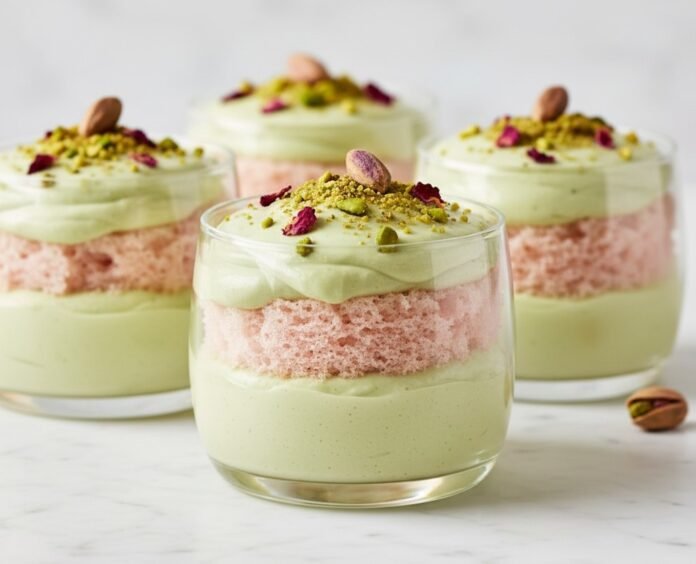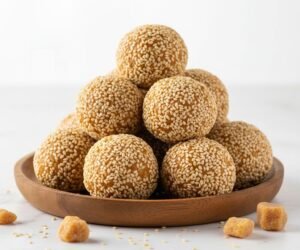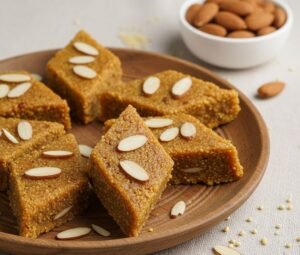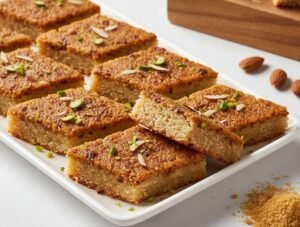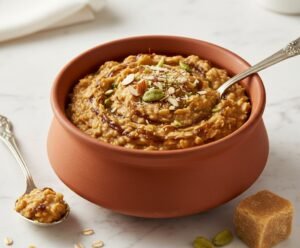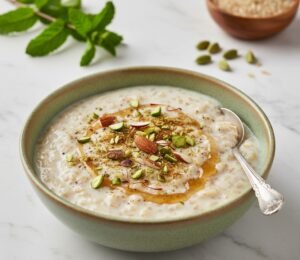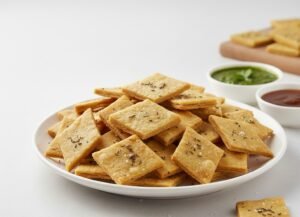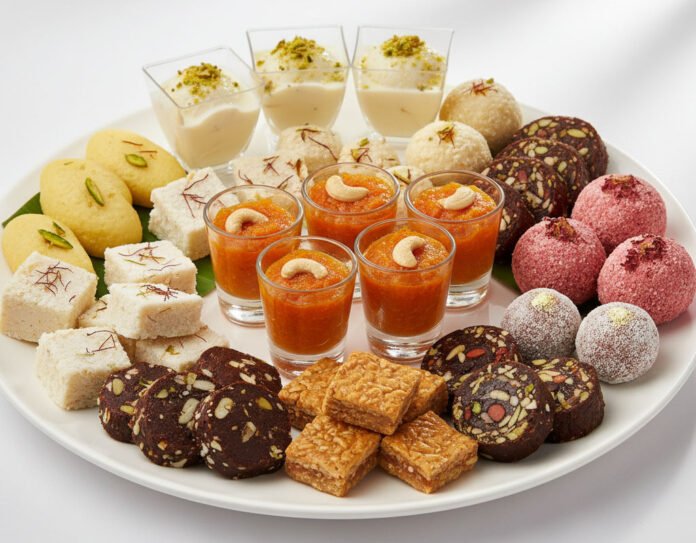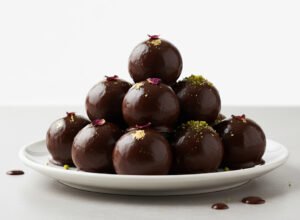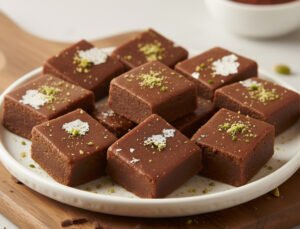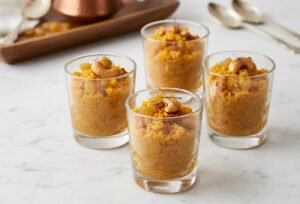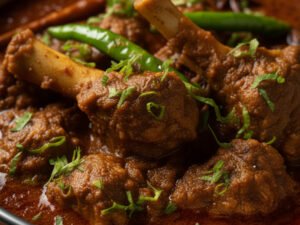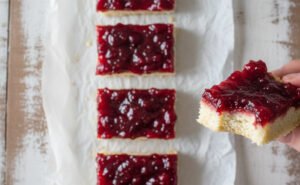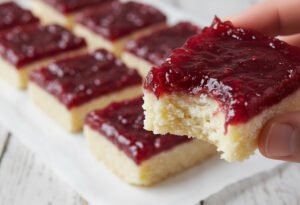The Magic of Pistachio and Rose
There’s something undeniably luxurious about the combination of pistachio and rose. Together, they create a dessert that’s not only visually enchanting but also delicately aromatic and irresistibly flavorful. Imagine layers of soft rose sponge soaked in floral syrup, topped with creamy pistachio mousse, and finished with a scattering of crushed pistachios and edible petals. These Pistachio Rose Cups aren’t just desserts — they’re edible art.
A Dessert Born from Elegance
Originating from Middle Eastern and Persian inspirations, pistachio and rose have long been a match made in culinary heaven. The nutty richness of pistachio perfectly complements the floral, almost romantic essence of rose. These cups beautifully capture that harmony — each spoonful offers the softness of sponge, the creaminess of mousse, and the gentle crunch of nuts.
Why Pistachio and Rose Make the Perfect Pair
Pistachios add depth and texture, while rose provides a light, floral lift that balances the richness. When combined in a layered dessert, they create a multi-sensory experience — aromatic, textural, and utterly indulgent. The green of the pistachio against the blush pink of rose also makes for an eye-catching presentation, perfect for weddings, celebrations, or even a luxurious evening at home.
Ingredients Overview – The Heart of the Recipe
Every great dessert starts with great ingredients. The beauty of this recipe lies in the simplicity of the components, each contributing a unique layer of flavor and texture.
For the Rose Sponge Layer
-
1 cup all-purpose flour
-
1 tsp baking powder
-
½ tsp baking soda
-
2 large eggs (room temperature)
-
¾ cup granulated sugar
-
½ cup vegetable oil
-
½ cup buttermilk
-
1 tbsp rose water or rose essence
-
A few drops of pink food color (optional)
This layer provides the delicate, floral foundation of the dessert. The soft, airy texture soaks up the mousse beautifully without getting soggy. Rose water adds fragrance while maintaining balance — subtle, never overpowering.
For the Pistachio Mousse Layer
-
1 cup heavy cream (chilled)
-
½ cup mascarpone cheese or cream cheese
-
½ cup pistachio paste or finely ground pistachios
-
¼ cup powdered sugar
-
½ tsp vanilla extract
-
A few drops of green food color (optional)
The mousse is the heart of the dessert — smooth, velvety, and indulgent. The pistachio paste lends an earthy, nutty tone that contrasts wonderfully with the floral sponge below. Using mascarpone ensures a rich, melt-in-your-mouth consistency that’s not overly sweet.
For the Toppings and Garnish
-
2 tbsp crushed pistachios
-
Edible rose petals
-
Gold leaf (optional, for a luxurious touch)
-
A drizzle of rose syrup or honey
The topping is where aesthetics meet taste. The crushed nuts add texture, while the edible petals and gold leaf bring sophistication and elegance to every cup.
Step-by-Step Preparation Guide
This dessert may look intricate, but with the right steps, anyone can make it. The process involves layering, chilling, and finishing — all simple yet rewarding.
Step 1 – Preparing the Rose Sponge Base
Preheat your oven to 350°F (175°C) and line a baking tray with parchment paper. In a bowl, whisk eggs and sugar until pale and fluffy — this aeration ensures a light sponge. Gradually add oil, buttermilk, and rose water, whisking gently to incorporate. Sift in the flour, baking powder, and baking soda, folding the mixture softly. Add a few drops of pink food color if desired for a pastel hue.
Bake for 20–25 minutes or until a toothpick comes out clean. Once cooled, cut small round pieces using a cookie cutter or a cup mold that fits your serving glasses.
The sponge should be tender and slightly moist — a perfect base to soak in the pistachio mousse’s creaminess. You can even brush it with a light rose syrup if you prefer a juicier texture.
Step 2 – Whipping Up the Creamy Pistachio Mousse
In a chilled mixing bowl, whip the heavy cream until soft peaks form. In another bowl, combine mascarpone, pistachio paste, powdered sugar, and vanilla extract. Fold the whipped cream gently into this mixture until fully combined. You’ll get a fluffy, light-green mousse that tastes divine.
For an extra touch, chill it for 30 minutes before layering. This allows the flavors to meld beautifully.
Step 3 – Layering Like a Pro
Now comes the fun part! Start by placing one round of rose sponge at the bottom of your dessert cup. Add a generous layer of pistachio mousse on top. Repeat if your cup allows — sponge, mousse, sponge, mousse. Finish the top with a smooth swirl using a piping bag or spoon.
Each layer should be even and distinct — that’s what gives this dessert its signature elegance.
Step 4 – Final Touches with Nuts and Edible Petals
Once layered, sprinkle crushed pistachios generously over the top. Add a few edible rose petals for color contrast. If you’re serving for a special event, consider finishing with gold leaf or a drizzle of rose syrup. Chill the cups for at least 2 hours before serving to let the mousse set.
Tips and Tricks for the Perfect Pistachio Rose Cups
Creating a dessert as delicate as Pistachio Rose Cups is all about mastering balance — flavor, texture, and presentation. A few smart techniques can turn your dessert from good to absolutely unforgettable.
The Importance of Temperature and Texture
Temperature plays a crucial role in achieving the right consistency for both the mousse and sponge. Always use chilled cream when whipping for the pistachio mousse — warm cream simply won’t hold its structure. Likewise, ensure the sponge is completely cooled before layering, or it will melt the mousse and make it watery.
When assembling, keep the cups cool to help each layer set properly. If the mousse feels too stiff, fold in a tablespoon of whipped cream to loosen it up. If it’s too runny, chill it for 20–30 minutes until it firms up slightly.
The texture should be smooth and creamy but not overly dense. The mousse must melt effortlessly in the mouth while contrasting beautifully with the soft, fragrant sponge beneath.
How to Get the Perfect Mousse Consistency
Achieving that luxurious, cloud-like mousse is all about folding, not whisking. Overmixing breaks down the air bubbles and results in a heavy, dense texture. Always fold the whipped cream into the pistachio mixture slowly using a spatula, with gentle, circular motions from bottom to top.
If you want an extra silky mousse, strain the pistachio paste before mixing to remove any coarse bits. Alternatively, grind roasted pistachios in a food processor until ultra-smooth for a homemade pistachio paste.
Balancing Sweetness and Aroma
Pistachio and rose are both strong flavors, so balance is key. Use natural rose water sparingly — too much can make your dessert taste soapy. The ideal amount is just enough to perfume the sponge without overpowering the nutty mousse.
Sweetness should be subtle; you want to highlight the nutty and floral notes, not mask them. Taste as you go — remember, you can always add more sugar, but you can’t take it out once it’s mixed in. A pinch of salt in the mousse also helps balance flavors beautifully.
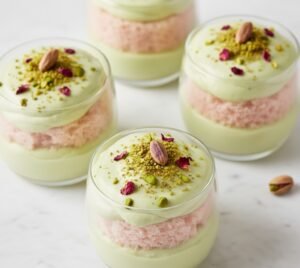
Creative Variations of Pistachio Rose Cups
If you’re in the mood to experiment, these versatile cups offer endless possibilities. Whether you’re looking for a vegan version, a fancier plated dessert, or a bite-sized treat, there’s something here for everyone.
Vegan and Dairy-Free Alternatives
For a vegan version, substitute coconut cream for heavy cream and use vegan cream cheese or cashew cream instead of mascarpone. The natural nuttiness of cashews pairs beautifully with pistachio, keeping the dessert rich yet plant-based.
For the rose sponge, replace eggs with a flaxseed mixture (1 tbsp ground flaxseed + 3 tbsp water per egg) and buttermilk with almond milk mixed with 1 tsp vinegar. You’ll get a soft, fragrant sponge that tastes just as amazing as the original.
You can also try agave syrup or maple syrup instead of sugar for a more wholesome sweetness. Garnish with shredded coconut or crushed almonds if you prefer a tropical twist.
Mini Pistachio Rose Trifles
Want to impress guests at a party? Turn this recipe into mini trifles by layering the components in small glass jars or shot glasses. These are perfect for weddings, high-tea events, or elegant dinner parties.
Add a layer of rose jelly or raspberry compote between the mousse and sponge for an extra burst of flavor. The acidity from berries complements the richness of pistachio beautifully. Plus, the alternating colors make these trifles visually stunning.
Turning the Cups into an Elegant Cake
If you’d rather serve a large dessert, simply double the recipe and assemble it as a layer cake instead of individual cups. Use the rose sponge as cake layers, and spread the pistachio mousse in between.
Decorate the top with crushed pistachios, fresh roses, and gold leaf for a show-stopping centerpiece. This version is perfect for birthdays, anniversaries, or Eid celebrations — a true feast for both eyes and taste buds.
Serving and Presentation Ideas
They say we eat with our eyes first, and that couldn’t be truer with Pistachio Rose Cups. The beauty of this dessert lies in its layers, colors, and delicate toppings. A thoughtful presentation can elevate it from a simple dessert to a luxurious culinary experience.
The Art of Dessert Plating
When serving in cups or glasses, choose transparent containers so the beautiful green and pink layers shine through. Garnish each cup with a small swirl of mousse, a sprinkle of crushed pistachios, and a few rose petals right before serving.
If you want to add drama, drizzle rose syrup around the edge of the mousse so it trickles down slightly, creating a soft, romantic effect. For formal occasions, place the cup on a small dessert plate and dust lightly with powdered sugar or edible gold shimmer.
Perfect Pairings – Beverages and Sides
The floral and nutty notes of this dessert pair wonderfully with light teas like jasmine, chamomile, or green tea. If you prefer coffee, a mild cappuccino or rose latte enhances the delicate flavors without overpowering them.
For a refreshing contrast, serve alongside fresh berries or a scoop of vanilla gelato. The creamy and floral elements blend harmoniously, creating a truly indulgent experience.
Whether you’re serving it at a wedding, festive dinner, or a casual brunch, these cups never fail to impress. Each bite feels like a taste of spring — fresh, fragrant, and utterly satisfying.
Storage and Shelf Life
Homemade desserts taste best fresh, but with proper storage, you can enjoy these Pistachio Rose Cups for days without losing their texture or flavor.
How to Store for Freshness
After assembling, cover each cup tightly with cling film or a dessert lid and refrigerate for up to 3 days. Always keep them chilled to maintain the mousse’s structure and prevent the sponge from absorbing too much moisture.
If you’ve made the components in advance, store the sponge separately at room temperature in an airtight container for up to 2 days, and refrigerate the mousse in a sealed bowl. Combine them just before serving for maximum freshness.
Freezing Tips for Long-Term Use
You can also freeze the mousse and sponge separately for longer storage. Freeze the sponge wrapped in plastic wrap and foil for up to 2 months. For the mousse, transfer it to a freezer-safe container and freeze for up to 1 month.
When ready to use, thaw the mousse in the refrigerator overnight and whisk lightly before layering. Avoid freezing fully assembled cups, as thawing may cause the layers to separate and lose texture.
Nutritional Breakdown
While Pistachio Rose Cups are undeniably indulgent, they also come with surprising nutritional perks—especially from pistachios, which are packed with good fats, protein, and antioxidants. Here’s a closer look at what’s inside each cup and how it can fit into your balanced lifestyle.
Calories and Macronutrients
On average, one Pistachio Rose Cup (about 200g serving) contains:
| Nutrient | Approximate Value | Benefit |
|---|---|---|
| Calories | 320–380 kcal | Energy source |
| Protein | 7–9g | Helps in muscle repair and satiety |
| Fat | 20–24g | Mainly heart-healthy unsaturated fats |
| Carbohydrates | 25–30g | Provides energy and sweetness |
| Fiber | 2–3g | Supports digestion |
| Sugar | 15–18g | Naturally from cream, pistachio, and rose syrup |
While this dessert is rich, it’s not empty calories. Pistachios are loaded with vitamins B6 and E, potassium, and antioxidants that promote heart and skin health. Rose water, on the other hand, aids in relaxation and digestion, making this a dessert that’s as soothing as it is delicious.
Health Benefits of Pistachios and Rose
-
Heart Health: Pistachios are known to reduce bad cholesterol (LDL) and boost good cholesterol (HDL).
-
Antioxidant Power: The combination of rose and pistachio delivers antioxidants that help fight free radicals.
-
Skin Glow: Rose water is often used for its anti-inflammatory and hydrating properties, giving your skin a natural glow from within.
-
Mood Enhancer: Both rose aroma and pistachio flavor are linked to calming effects, making this dessert a perfect stress-buster after a long day.
If you want to make this treat healthier, reduce sugar slightly, use low-fat cream, and skip artificial food coloring. The natural hues of pistachios and rose petals are beautiful enough on their own.
Conclusion – Indulge in a Symphony of Flavors
The Pistachio Rose Cups Recipe is more than just a dessert—it’s a sensory experience that combines elegance, texture, and flavor harmony. Every spoonful offers layers of creamy pistachio mousse, tender rose sponge, and crunchy nuts that dance together in perfect rhythm.
What makes this recipe so special is its versatility. It can be dressed up for a fancy dinner, served as mini desserts for a gathering, or simply enjoyed on a quiet evening with a cup of tea. Whether you make it traditional or experiment with modern twists, the balance between floral rose and earthy pistachio will always feel magical.
In a world full of desserts, Pistachio Rose Cups stand out as a masterpiece—a sweet story told through taste and texture. So go ahead, gather your ingredients, and create this stunning treat. Your kitchen will smell divine, and your guests (or family!) will remember it long after the last spoonful.
Frequently Asked Questions
Q1: Can I make Pistachio Rose Cups without an oven?
Yes! You can easily prepare the rose sponge layer using a steaming method or even microwave baking. Pour the batter into microwave-safe cups and cook for 1–2 minutes until fluffy. Steaming also works well — it gives a moist, soft texture ideal for layering.
Q2: How do I make pistachio paste at home?
To make homemade pistachio paste, simply blanch shelled pistachios in boiling water for 2 minutes, remove their skins, and blend them with a tablespoon of sugar and a bit of neutral oil until smooth. It’s fresh, aromatic, and free from additives.
Q3: Can I substitute rose water with another flavor?
Absolutely. If rose water isn’t your favorite, try orange blossom water, vanilla extract, or even cardamom essence for a fragrant twist. Each variation creates a unique flavor profile while maintaining the luxurious tone of the dessert.
Q4: What type of cream is best for the mousse?
Use heavy whipping cream with at least 35% fat content for the best texture. Light cream won’t whip up properly and can make your mousse too soft or watery. For vegan versions, coconut cream or cashew cream works beautifully.
Q5: How far in advance can I prepare these cups?
You can make them 1–2 days ahead of your event. Just keep them refrigerated and garnish with rose petals and nuts right before serving to maintain their freshness and visual appeal.
Q6: Can I use store-bought sponge cake instead of baking it myself?
Yes, you can. Choose a plain vanilla or almond-flavored sponge and soak it lightly with rose syrup before layering to replicate the homemade version.

